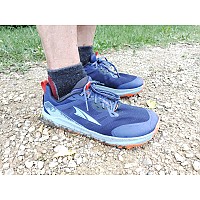Petzl Bindi
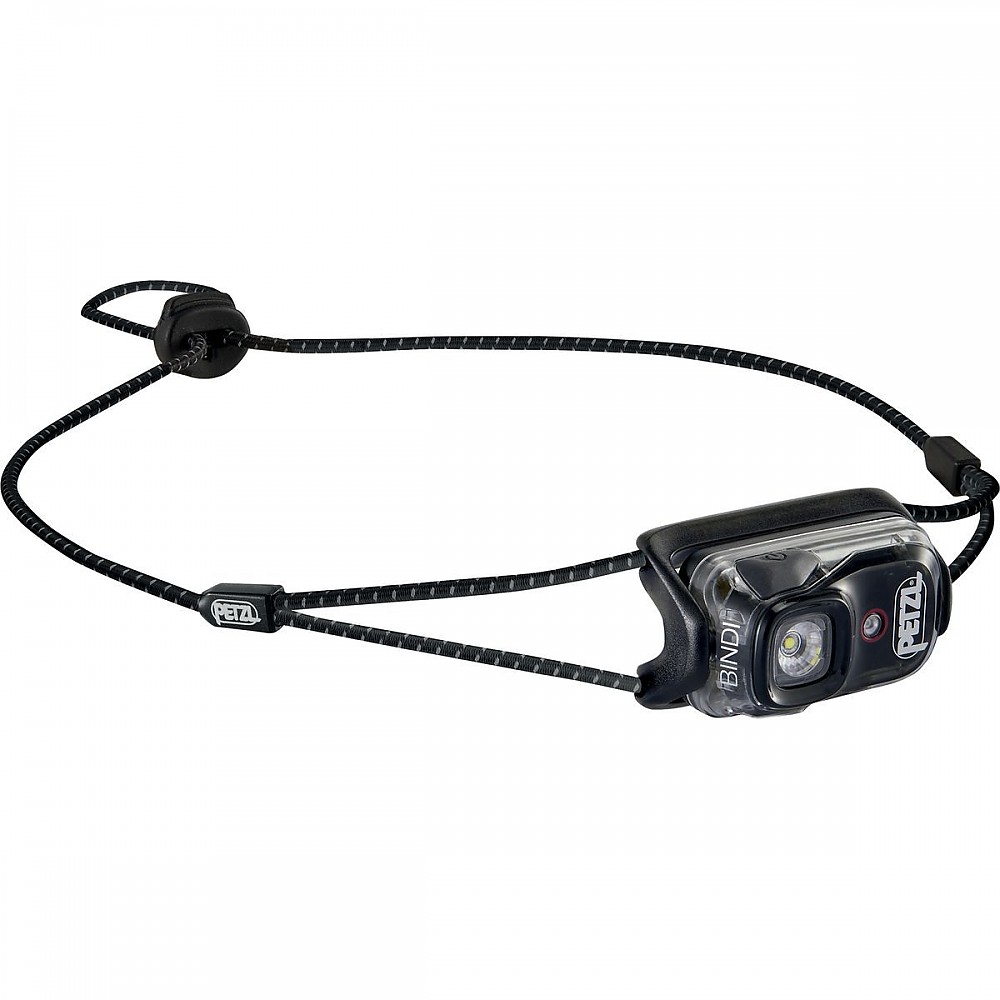
A tiny, lightweight headlamp with three white light levels, continuous low-level red light for night vision and a red strobe setting for emergencies, and an internal, USB-rechargeable Li-Ion battery. A good choice for thru-hikers or other activities where light weight is critical.
Pros
- 35 g
- Three white light levels
- Red LED for night vision
- Flashing red for emergencies
- Up to 50 h battery life
- Charge indicator
- Double locking function
Cons
- Non-replaceable battery
- No padding on forehead
- Not a good choice for activities requiring prolonged bright light
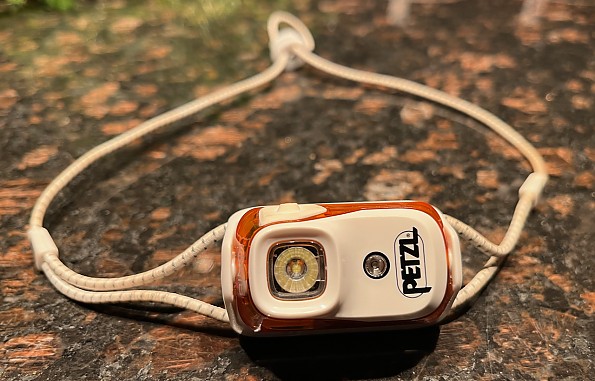
‘Twas a dark and stormy night. The path from the cabin to the outhouse was perilous, a footworn trench in the deep snow, half-drifted in by the blinding spindrift. Fortunately I had my Petzl Bindi to light the way so I could safely go out for a midnight pee…
OK, so that didn’t actually happen—yet. But the Bindi is an ideal little headlamp for when weight matters most and the demands for artificial light aren’t too great. Midnight trips to the outhouse. Making camp and preparing meals after dark. Reading in bed in the tent or in a cabin. Minimalist night hikes. Thru-hiking, when grams matter. That sort of thing.
What it is

The Bindi is a tiny headlamp with three white light levels, max 200 lumens, a red led that offers continuous red light for night vision and a red strobe setting for emergencies, and an internal, 680 mAh, USB-rechargeable Li-Ion battery. That kind of sums it up. Mine weighs 33.6 g / 1.2 oz fully charged, 1.4 grams less than Petztl’s stated weight of 35 g.
I haven't used my Bindi in continuous rain. It is splash resistant (IPX4 rated) and should hold up to at least a few hours in light rain. It wouldn't be my first choice for a long-term outing in wet conditions, but still great for trips to the outhouse or bouts of cooking in the rain.

For those wanting to color-coordinate, the Bindi comes in all black or white with blue or orange accents. My orange one offsets my orange rain jacket rather nicely.
Battery life and charging
I haven’t tested the battery life, but Petzl gives it 50, 3, and 2 hours for the 6, 100, and 200 lumen settings, and 33 and 200 hours for red light at 1 lumen or strobe flashing, respectively.
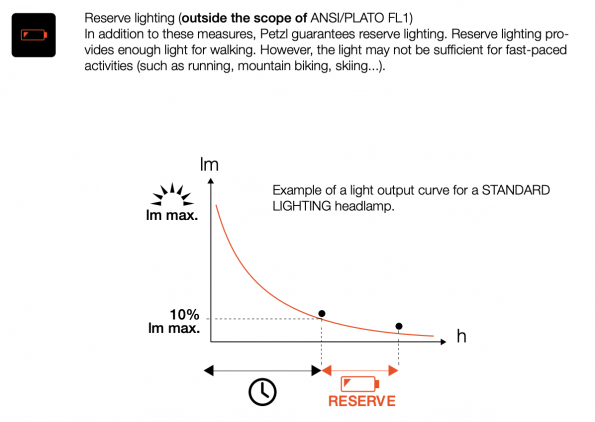
Petzl’s published curve shows that the light declines as the battery charge drops, but the battery supports an additional 1.5 hours of reserve lighting at <10% of the initial output. Using the headlamp mostly at the low level, it should be good for a couple weeks or more of my main intended use, multiday backpacking or hut-to-hut trips where I can use it at the low light level for cooking, reading, or navigating around camp after dark.

The battery is rechargeable via a micro-USB port, and the lamp comes with a short USB-A to micro-USB cable.
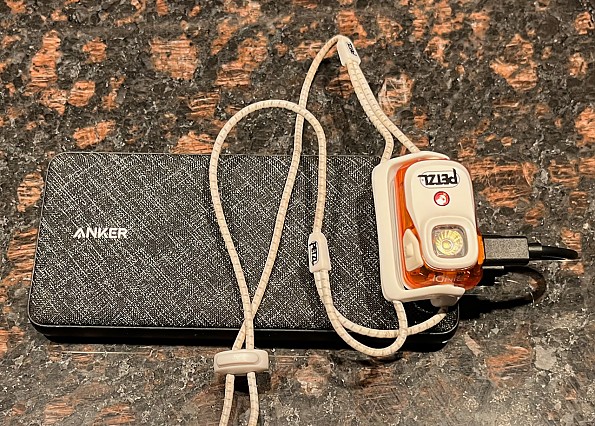
Since I carry a backup battery to keep my phone charged on longer outings, I can also recharge the Bindi with no weight penalty, and I doubt the tiny battery uses much backup capacity.

The red LED doubles as a battery charge indicator after switching off, green for >66%, orange for 33-66%, red for <33%.
Petzl guarantees the Bindi for three years or 300 charge cycles, excluding various kinds of abuse. The battery is not replaceable, and there are online reports of Bindis dying after 4-5 years, without specifying the intensity of use. My wife’s first Bindi died of unknown causes after about 3 years. So this is functionally a disposable headlamp, which is maybe just the cost of lightweight rechargeability and convenience. A competitor’s model uses two replaceable CR2032 batteries but gives only 40 lumens and an 18-hour max burn time, at less than half the price (but then add in the cost of new batteries every 18 hours).
Operation
The one-button Bindi OS is straightforward. Single button pushes cycle through off-low-medium-high-off. Press and hold to switch to red light mode and then use single button pushes to go to strobe and off. It will “remember” and switch on in white or red light mode, always giving the lowest light first.
In keeping with the overall size of the headlamp, the button is tiny, easy enough to find with bare fingers, but not very glove or mitten friendly. I'll reserve this light for summer trips.
The lamp rotates freely in a plastic armature so you can aim it anywhere from straight up to straight down or even back at your own forehead. The headband is lightweight shock cord with a cordlock at the back to adjust for head size and comfort. The armature is not padded and so puts hard plastic against the forehead. The lamp is so light that this isn’t much of problem, but I could see adding a few grams worth of foam to make it a bit more comfortable.
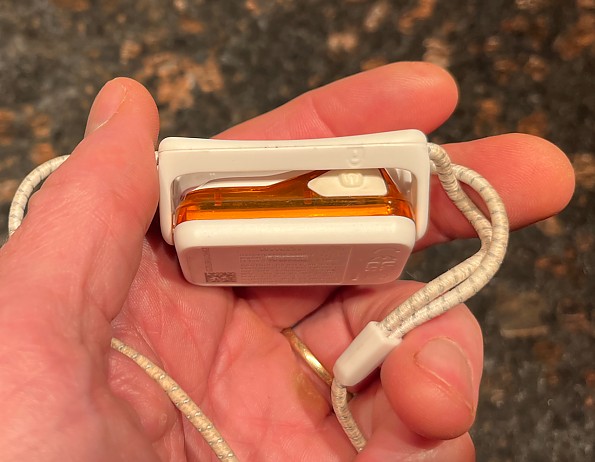
To prevent accidentally switching on the lamp while in a pack or pocket you can flip it about 180˚ until it clicks in a position that puts the button under one side of the armature, but it pops out of this position rather easily. For a more secure lock, you can hold the button down for 4 seconds until the red LED flashes; then it will no longer turn on with a random push of the button. Four button pushes in a row will return it to active mode.

To stow the Bindi, I like to flip it into the mechanical lock position, wrap the shock cord around the whole thing, and use the loop above the cordlock to secure it.
Best use
The Bindi is not an all-rounder. Its best use is as an around-camp light on multiday backpacking trips when weight is at a premium. When I’m not so concerned about weight, and in colder seasons, I’ll take a headlamp in the 400-750 lumen range for any nighttime action, even if I use it mainly at lower light levels. I could see trying out the Bindi for some light-minimal night hiking or even running, maybe even on the 1 lumen red light setting, just to sink into the darkness a little more than usual.
Back in the day I liked to see how far I could get on a single cyalume light stick as it slowly faded out, and I have done some night running and even xc skiing by dim red or green light (or, of course by moonlight). For shorter night outings these days I’ll go with something brighter, but I haven’t yet graduated to a lamp that gives 1000 lumens or more. The Bindi gets reserved for when its light weight, rechargeable battery, and brightness range are the right blend for the job at hand.
Background
Headlamps are a way of life in Norway (in winter; we don't have much use for them in summer). My first headlamp, back in the '70s, was a monstrously heavy, 4 D-cell Justrite. Now I have a drawer full of LED headlamps in the cave, and I use them for everything from early morning, late afternoon, and night running and skiing to trips out to the compost pile. I have had the Bindi for a year and used it mainly in Norwegian huts and backpacking trips at lower latitudes.
Source: received it as a personal gift
A small, rechargeable headlamp that takes up minimal space.
Pros
- Rechargeable
- Battery power indicator
- Two lock mechanisms
- Multiple light beam modes (three white beams, red solid and red blink)
- One-hand adjustments
- 360-degree rotating head
- Minimal weight (35g/1.23oz)
- Minimal bulk
Cons
- Pressure from band
- Short charging cable
- Long charging time (4 hours)
Modes and Run Times:
- Three white beams: 5 lumens (50 hours run time), 100 lumens (3 hours run time), and 200 lumens (2 hours run time)
- Two red beam options: solid and blink
For a small, compact headlamp, these modes are pretty good, with my only complaint being the noticeable difference between 100 lumens and 200 lumens of the white beam is very minor. I’d personally prefer to see the 100 lumen option nixed for something more akin to 50 lumens.
The run times have been tested and I have every reason to believe they are accurate, and maybe even generous. For example, when I tested the 100-lumen option from a full charge, it lasted longer than the manufacturer's three-hour claim. The 200-lumen option was about right and the 5-lumen option was difficult for me to accurately test from a timing standpoint.
Range:
Petzl's claim for light ranges are 5 lumens (6 meters or 6.6 yards), 100 lumens (23 meters or 25.2 yards), and 200 lumens (36 meters or 39.4 yards).
Below is a test I ran using approximate distances.










Beam:
As a lightweight headlamp that is geared toward active users (e.g. runners, hikers, climbers, etc.) it is no wonder the beam is fairly wide and not pinpointed. The wide beam, for general active uses, works well. The only complaint I've heard is from my wife while I was using the white beam to read in the tent and she was trying to sleep, "Can't you turn that thing off?" Good thing for red mode...haha.
Power Source:
The manufacturer claims a four-hour charge time from empty to full, which is pretty difficult to test given that I can't independently test the capacity of the lithium ion battery. Taking Petzl on their word, four hours for a full charge seems awfully long, particularly if you're trying to charge mid-trip of a multi-day adventure off a portable power supply source. However, all of my charging has been done at home or in the car with plenty of time to spare.
A positive is that the light can still be used while charging, but only with two of the three white beams and no red beam.
Weather and Temps:
The Bindi has an IPX4 rating, meaning it can withstanding sprays of water but not immersion. It should be able to withstand most weather conditions, except for the torrential flood. I've had it in the rain several times this summer (it's been historically wet) and the light has been fine and dandy.
As for temp ratings, Petzl says the best conditions are between 50°F to 113°F (10°C to 45°C), and the rechargeable batteries can withstand -4°F to 140°F (-20°C to 60°C), with the ideal storage temps being 68°F to 77°F (20°C to 25°C). I haven't pushed the limits with the temps and in most circumstances I find myself in, would never need to, with the only possible time being in winter hunting or hiking conditions.
THE GOOD FEATURES
Inter-modal Operation (ie. changing the beam and light color):
Switching from one mode to another is pretty straightforward on the Bindi. Simply clicking the button (yes, there is only one button, which is bonus) changes within the same color mode. Holding the button in for three seconds changes the color mode (i.e. white to red or red to white) to change. Holding the button in for five seconds will power down the light and lock it. To unlock, it’s just a matter of holding it in for three seconds. I particularly appreciate the fact that it has a mode memory, so if it was last turned off in red mode, it will turn on in red mode (and the same with white), and when turning on the white beam, it always starts at the 5-lumen beam, thus protecting your fellow tentmates from being absolutely blinded.
Two Locking Methods:
The power locking, as described in the previous paragraph, prevents the light from turning on when the power button is bumped. Theoretically, it would unlock if the light’s power button was pressed up against something (say when crammed into a pack). However, a second locking mechanism can be used to prevent the power button from being vulnerable to accidental bumps. When pivoting the head there is one spot in the 360 rotation that catches a little bit. This is on purpose because it catches the head at the exact spot where the power button is protected from accidental bump. The combination of the two locks means no more reaching into your pack to find a dead headlamp...a huge bonus for me.
Battery Life Indicator:
My absolute least favorite part of any headlamp is the uncertainty of when the batteries are going to die. With a battery life indicator on the Bindi, my fears are put to rest. The indicator is fairly straightforward (at least for those of us who are not colorblind. Not sure how effective this would be for those with color blindness). When turning the light off, the indicator will either show green (full charge), yellow/orange (half charge), or red (running low, charge soon).
In testing how long the light will run even after the red indicator light shows, my testing revealed at least another hour (and likely more) of run time at the 5-lumen white beam, which was delightfully surprising.
Sizing/Adjustability:
I have a pretty large head, measuring 24 1/4 inches or 61.6 cm or 7 3/4, depending on which measurement you use and some headlamps I've used in the past max out right around my head size. The Petzl Bindi has a bunch of spare room and even fits easily when I wear a hat (ball cap or beanie) so I believe it would fit almost any size head. This truly is a one-size-fits-all headlamp.
AREAS TO IMPROVE
Headband:
The thin elastic headband is lightweight, flexible, and easy to adjust so it has its benefits. However on my bald head, the thin cord squeezes and puts more pressure on my head than a wider elastic band does. Of course, the band’s tightness is adjustable with a plastic toggle in the rear, but even when loosened up, the pressure is still there. Perhaps this is due to having a bald head and maybe it is a concession to make for cutting weight and bulk. One solution to this pressure problem is that when wearing a hat, I don't feel the pressure as much.
Charging Cord:
The USB-to-mini USB cord is 12 inches long (30.5cm), which is fine if charging from a computer or in a car, but far too short if charging from a wall outlet. I recognize that there is no perfect solution here, because too long a cord would get easily tangled and be hard to manage, but too short of a cord leaves me placing the headlamp on the ground to charge (risk having it stepped on) or having to pull out a mini-extension cord (pain in the butt).

Conclusion:
I have a half dozen light sources and I’ve found this one to be among my favorites. No, it’s not perfect, but the areas in which it shines (no pun intended) include its low weight/bulk, rechargeability, and trustworthy locking mechanisms. While I’m not an ultralighter myself, I do greatly appreciate being able to shave weight and bulk while not compromising on usefulness.
Background
I’ve tested the Petzl Bindi for three months in a variety of conditions, mostly dark ones. My best guess for total run time is approximately 50 hours and I’ve recharged it a handful of times, sometimes from fully dead and sometimes from mid-battery life. It has been exposed to temperatures ranging from 40F to 95F (4C to 35C) and some damp conditions but nothing extreme.
I have 4 other headlamps and 2 additional light sources I rotate through depending on situational needs.
Source: received for testing via the Trailspace Review Corps
(Sample for testing and review provided by Petal)
Petzl Bindi and Actik Core headlamps
Pros
- Small
- Bright
Cons
- Not at all water resistant
Like all Petzl headlamps they’re made of cheap plastic, just like almost everything else, but somehow the quality is even cheaper. And never ever get your Petzl headlamps wet. They’ll never charge again, especially the Bindi. As for the Actik Core, that crap stays bright for like 20 minutes, no matter how new the battery is. It will never work properly ever again when you recharge it. I carry two or three battery packs with me all the time for this stupid Petzl headlamp.
Then I made the mistake of buying the Bindi, two of them. One got rained on, the other one got put in with a Gore-Tex jacket wash. They never charged again or worked. My buddy walked outside with his in the snow, dried it off inside, never charged again.
Petzl is such a crappy crappy company. How they’re a leading industry in the headlamp scene is beyond me. I’ve been using Black Diamond headlamps for the past seven years and believe it or not they still hold a charge better than Petzl Actik Core rechargeable…
Black Diamond headlamps are either waterproof or at least they work again after they dry off and for God sakes, they hold a charge for a long time, I mean years!
Background
Not very much since I had to throw both of mine away and I’m not paying €60 for a new one that will never be reliable because if it gets wet it just stops charging, but that said I did get to use a lot. I guess if you use it in the house to rebuild your bicycles it’s OK, definitely don’t take it in the mountains as a source of safety and reliability.
Source: bought it new
Price Paid: 30-50€
Your Review
Where to Buy
You May Like
The Bindi replaced the Petzl Zipka.
Specs
| Price |
MSRP: $49.95 Current Retail: $44.95-$49.95 Historic Range: $33.71-$59.95 |
| Brightness |
200 lumens (ANSI/PLATO FL 1) |
| Weight |
35 g |
| Beam pattern |
Flood |
| Energy |
680 mAh rechargeable battery |
| Certification(s) |
CE, UKCA |
| Watertightness |
IPX4 (weather-resistant) |













